Sketching my way through crisis
This is the third in an occasional series about keeping a sketchbook practice to get through the pandemic and other crises. You can find earlier columns below.
One of the scary things I’ve been exploring in my sketchbook recently is hanging out with other people. After an outdoor potluck, I found my social distancing sweet spot. It’s not very large.
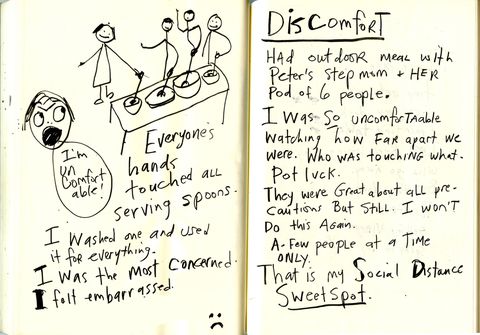
But along with examining things that feel frightening and out of my control, I also like to remind myself of what gives me comfort and joy. I shared this practice with the three 12-year-old girls I’m teaching, and we explored things that make us happy. One of the kids mentioned potato pizza; I’d never heard it! We then had fun sharing all of our favorite foods. Reading is also soothing for them, and we discussed our most beloved young adult books. I asked the girls to loan me some.

One of my greatest sources of comfort, especially now, is my dog, Charlie. If I am feeling low, simply petting him or giving him a hug magically helps me feel better.
It makes perfect sense to me that dog adoptions are way up during the pandemic. Research has proved that dogs can help ease anxiety, reduce stress, prevent loneliness and keep humans active. A study from Japan showed that simply staring into your dog’s eyes raises your level of oxytocin (the “love hormone”).
 Eyes like pools of love.
Eyes like pools of love. Charlie not only provides unconditional love and compassion, but he also makes us laugh. Sometimes, the looks on his face alone are hilarious! Plus, he’s always thrilled to see me, no matter how long I’ve been gone. Which, these days, isn’t much.
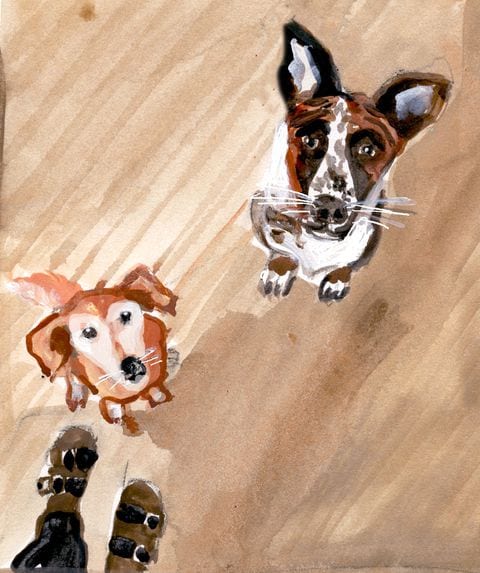 Charlie and a friend wait for treats.
Charlie and a friend wait for treats. It’s hard for me to believe, but I’ve only been a dog person for about eight years. Charlie is my first dog, though I’ve painted him so many times, it feels like I’ve had him forever. He even made it onto the cover of the New Yorker!

The reason I never had a dog before is that I thought I was allergic. Then, our daughter began bringing her dog, Ike, home when she visited New York City. Not only did I have no allergic reaction — but I also fell in love. Ike was a very majestic German shepherd/Rottweiler. When he died suddenly, I was completely unprepared for how intense my grief was.
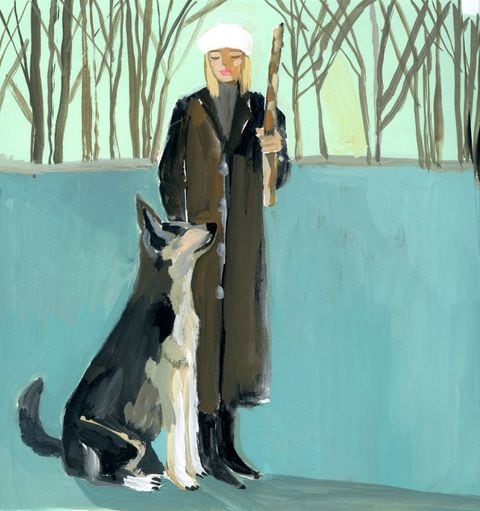 Ike waits for the stick.
Ike waits for the stick. It was time for us to get our own dog, I decided. I visited shelters and scrolled constantly through Petfinder, looking for another Ike. After many months, my husband, son and I saw a dog we liked but just weren’t sure about; he was a bit goofy, not majestic at all. (Little did I know how regal he would seem to me later.) We left the shelter without him. Then, Peter, my husband, said: “I keep thinking about that dog, and I could see him in our life.” And he hadn’t really wanted a dog!
Was this dog the one? The next day, I returned to the shelter, asking the universe for a sign. But it wasn’t until I was filling out the adoption paperwork that I finally got it. Charlie’s “birthday” (which had been randomly picked because he was a rescue) was Oct. 17. Peter’s birthday.
Such serendipity sparked the idea for a project I’ve had on the back burner for a few years, gathering stories for a book of miraculous dog rescue stories. One of my favorites is the story of Ricker and Joanna.
A few years ago, Canadian Joanna Caplan was fostering dogs while working and living in Nepal. Ricker, a paralyzed street dog rescued in Kathmandu, was delivered to her by way of a seven-hour bus ride, carried in a bag by kind locals. After Joanna had fostered him for a month, he began to use his legs and walk! Then, he was sponsored by a woman who wanted to adopt him, and he was flown to Canada.

Ricker in a bag!

Ricker.
LEFT: Ricker in a bag! RIGHT: Ricker.
When Joanna moved back to Toronto from Nepal, the woman decided she couldn’t keep him, so Joanna took him in temporarily. She found him another home so she could go to India. Then, not only did she not move, but the man who had taken Ricker was also hospitalized, and the dog once again needed a home.
“That was the third time Ricker had come into my life not of my choosing, and I knew that this time there was no way I would ever give him up,” Joanna said. “He was mine, and I was his. Ricker has given me so much, and I am so grateful that he came into my life when he did and that I got so many chances to realize that we are meant to be together.”
Now, I cannot imagine life without a dog. I love that Charlie follows me everywhere; it’s just comforting. When we’re alone, I talk to him. He has a bed under my desk, and I like tucking my foot under his body. That connection with him makes me feel happy.
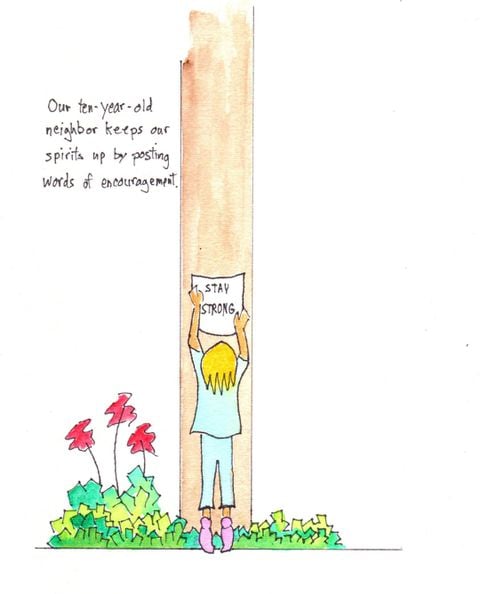 A reader submission relating to the previous theme of connection from David Regnier of Eugene, Ore.
A reader submission relating to the previous theme of connection from David Regnier of Eugene, Ore. What brings you comfort and joy in these unprecedented times? Draw anything that relates to the topic and send it to us via the box below or tag #sketchwithgayle.
This week’s trade secret: I cannot draw anything (well) without a photo of it. There is no shame in needing good photo references. Here is how I would draw a dog and cats if I didn’t have a photo to draw from.

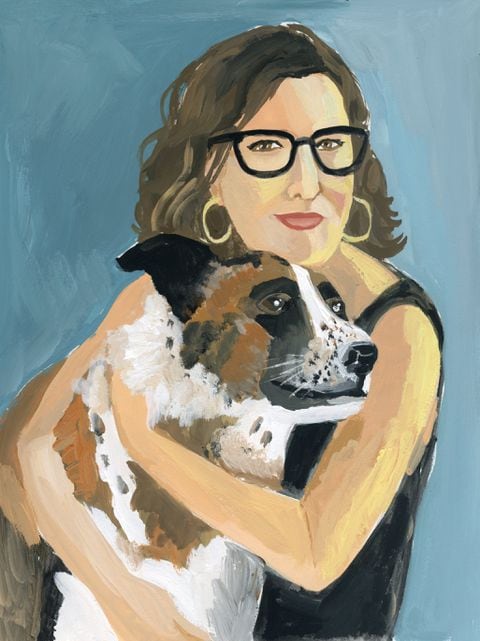
I did a “video photo shoot” and later took screen grabs to paint this portrait of me and Charlie! He is such a good poser.
Part 2
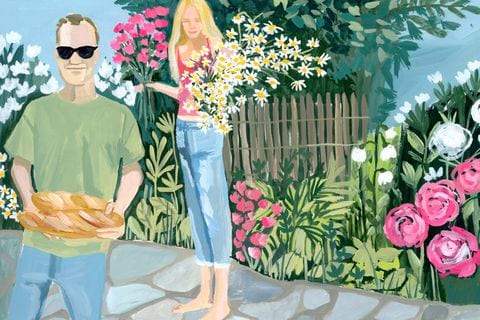
July 6
How my neighbors’ bread and flowers encourage connection and generosity
I love being alone. The older I get, the more alone time I crave. I’m careful about who I say this to, because so many people are having a hard time social distancing, but I actually like many aspects of this simplified life with so few choices and a lot of time spent quietly in my studio. I am lucky to be married to a fellow artist who feels the same way. We are really good at giving each other plenty of time and space to be quiet and creative.
 Here we are in Bali. When will we ever travel again?
Here we are in Bali. When will we ever travel again? I’m actually shocked at how well we’ve gotten along these past four months. Granted, I have some sketchbook pages that I’d never show anyone, but that’s the beauty of a sketchbook/journal. You get a chance to get all that crap out onto paper.
But heading into month four of quarantine, I began feeling the desire for a bit more connection and more in-person conversations. Right around this time, a friend told me about “Bread & Gardens,” a tradition started by a man in my town named Manfred Gabriel.
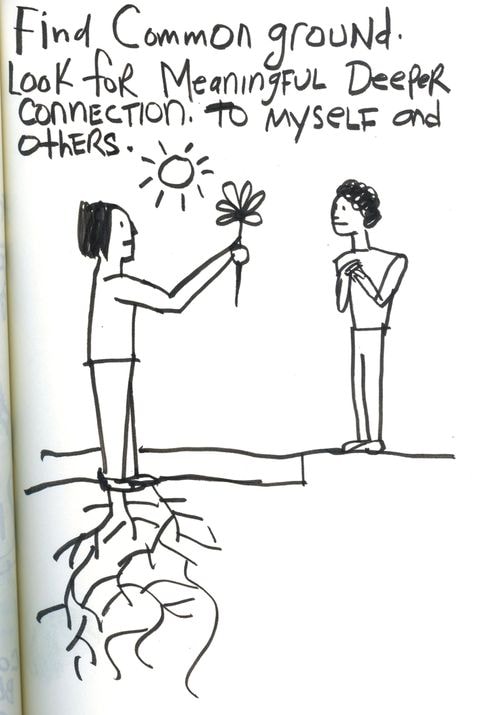
The term “Bread & Gardens” appealed to me. I often draw people with roots going into the earth. Drawing this helps me to feel more grounded. And, like many people during quarantine, I started making bread, although it took a while to get a decent loaf. I managed to kill two sourdough starters given to me by friends.
Manfred takes bread-making to another level. A lawyer who divides his time between an apartment in New York City and his home here in Ashfield, Mass., he was baking bread long before it was trendy. It was his wife, Christina’s, idea that Manfred could bake enough bread to give away to friends and neighbors each week, for free, barter or money if people insisted.
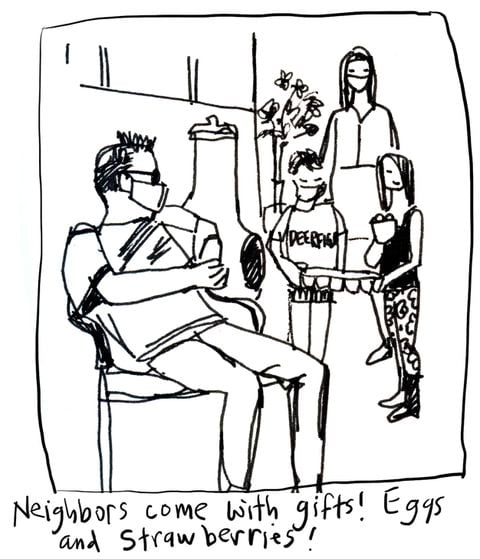
Manfred wrote: “It’s therapeutic for me to bake bread particularly right now when everything seems disconnected and scary. The bread and flowers are both lures, if you will, to get our neighbors and friends to come over.”
The outdoor giveaways, Manfred added, are also a way to offer a remedy for the stress and isolation of the pandemic. “Making the trip up to our little clearing in the woods, taking in the flowers and the gardens, the wave and chat, the chance encounters with others, and picking up a wholesome loaf of bread (the staff of life) are all equally important parts of that remedy,” he said.
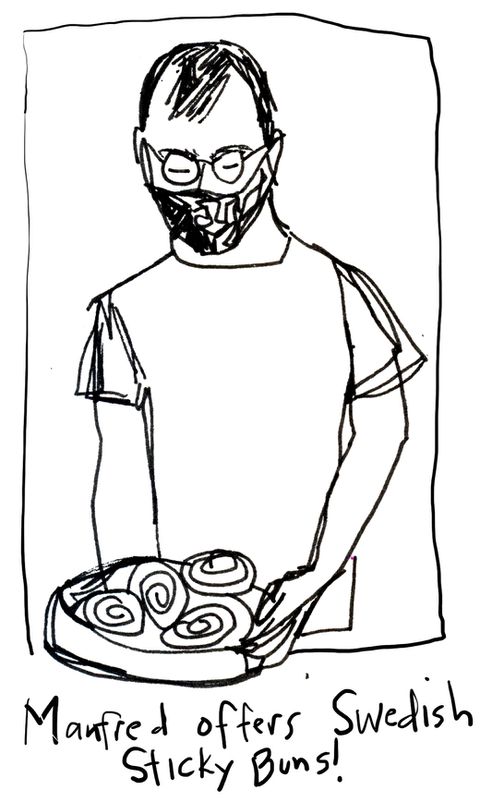 Sometimes Manfred even bakes a delicious treat for everyone, such as these sticky buns.
Sometimes Manfred even bakes a delicious treat for everyone, such as these sticky buns. He bakes different breads each week, such as “seeded brick,” a German-style sourdough rye Vollkornbrot with pumpkin seeds, sunflower seeds and flax seeds; baguettes made with local, stone-ground bolted flour (bolting is a traditional French method of sifting the flour); and Vinschgauer, a sourdough rye Alpine flatbread with traditional bread spice, coriander, fennel and anise seed.
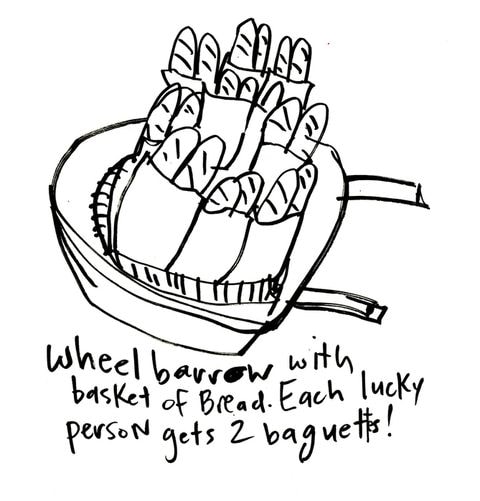
I was quickly hooked on this Sunday experience. I leave their place with delicious bread and a gorgeous bouquet of flowers that Christina picks for me as she proudly shows me her beautiful gardens.

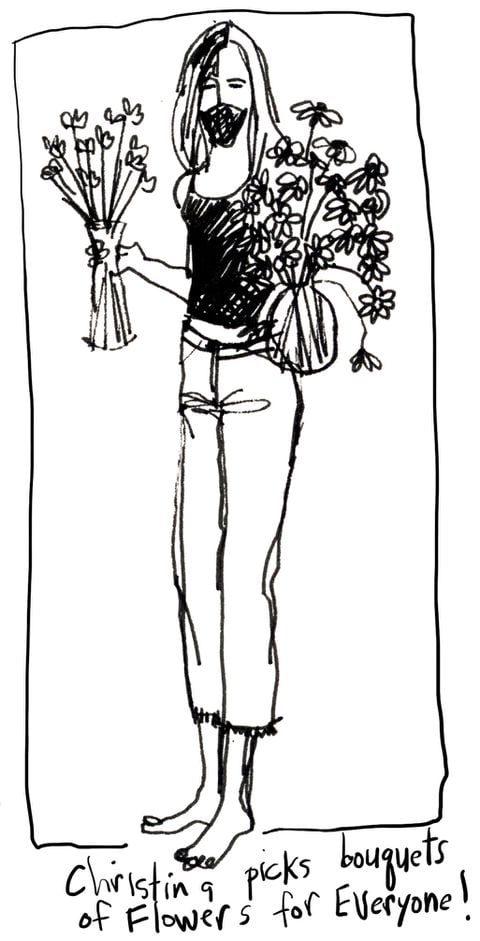
I felt so filled up by their generosity. It made me think: How can I be more generous and connect with others a bit more often? These are issues I explore in my sketchbook.


One day, when I was feeling a bit low, I wrote to my neighbor and asked if her kids would like outdoor, socially distanced art lessons. So, now I’m giving weekly art lessons to the neighbors’ kids. This is as much for me as it is for them. I love hanging out with them, and my goal is to turn them on to a sketchbook/journal practice. I’ve given them homework to draw or write daily in a sketchbook.

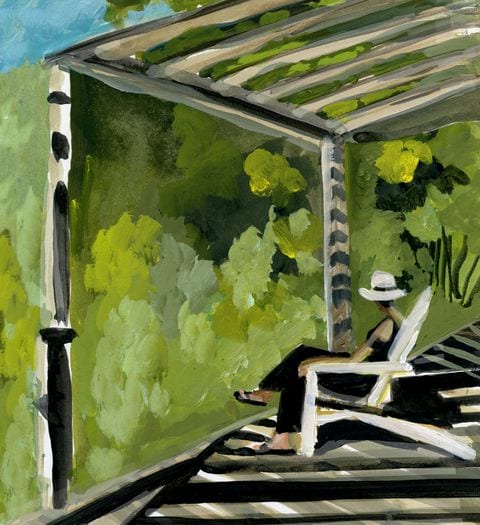
This week’s trade secret: The light was so beautiful and no one was around to pose for me, so I set my phone to video, propped it up and walked into the frame. Then I took screen shots to paint from later.
Part 1
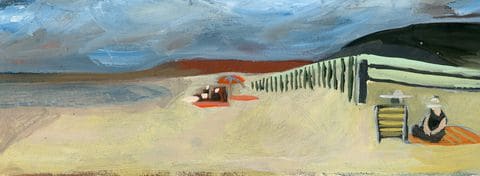
June 22
How drawing got me through my husband’s heart surgery, and more
As a freelance illustrator, I always felt like I should keep a regular sketchbook practice. I’d seen other artists’ sketchbooks, and they were amazing. But I just wasn’t inspired to do it. It felt too much like “work.”
Eight years ago, however, I had a major breakthrough. Instead of fretting that “I should be drawing in my sketchbook,” I started thinking that “I get to draw in my sketchbook!” The main key to this awakening was letting go of caring what my drawings or paintings looked like. I was simply trying to document what I saw in a loose, fun way. Still, I mostly used my sketchbook when I traveled, as in the painting at the top.
Then, last November, my husband had quadruple bypass surgery. I was scared. For the 12 days he was in the hospital, I sat in his room and drew what was going on in my sketchbook or took photos to draw from later. (And yes, I’d asked him if he was okay with this. I think he actually liked it.)
Drawings from “life” are always looser than when I draw or paint from photos. Scenes such as these of Peter in the intensive care unit were terrifying. Drawing helped keep me calm and gave me something else to focus on while remaining fully present.
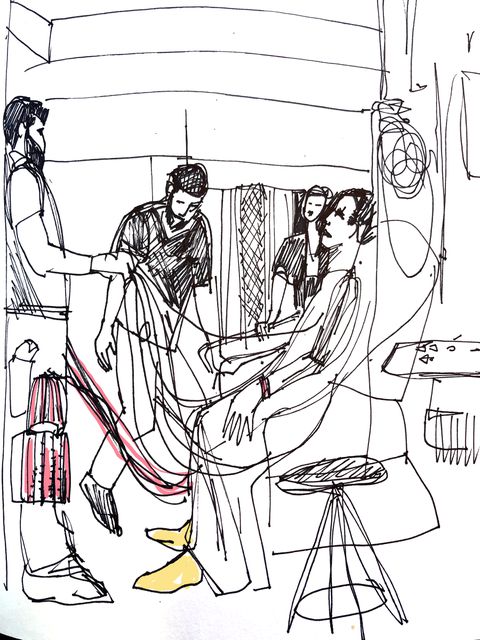
Drawing pictures such as these, from photos I’d taken earlier, allowed me to process things twice — in real time and then later in my sketchbook.

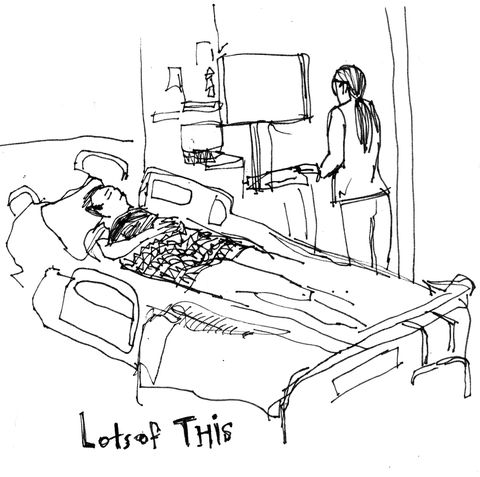
A few months later, Peter was doing great, but I had another source of terror: the novel coronavirus. I knew from my hospital experience that having a regular sketchbook practice would be helpful. So, after the quarantine began, I started weekly therapy sessions with Margaret O’Connor, a therapist and coach who, years ago, had introduced me to the idea of drawing and painting how I felt. For a while, fear was a main topic of the sketches that resulted from these sessions.

I began drawing some of my worst fears, just letting them rip. (The words “I can’t breathe” take on a whole other meaning now.) Both of my adult kids live in Brooklyn, a coronavirus hot spot, and I was terrified for them. Peter remains at high risk, and that was also very scary. Margaret helped me understand how responding from fear just creates more fear. Talking, drawing and writing about my fears made them less terrifying. Keeping a daily sketchbook practice helps me stay calmer.
Then came George Floyd’s horrifying death, and the world seemed to explode. One night, I couldn’t sleep. I kept hearing George Floyd’s last words over and over in my head. I drew what I was feeling.
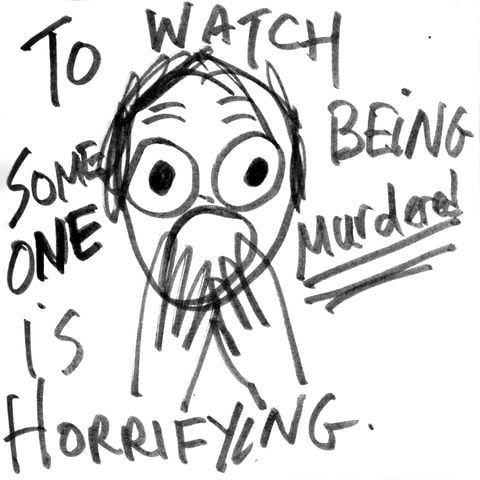 (For The Washington Post)
(For The Washington Post)  Portraits of Monique Melton, left, and Ibram X. Kendi.
Portraits of Monique Melton, left, and Ibram X. Kendi. I began to educate myself and examine my beliefs and thoughts on being racist/anti-racist. As I listened to author and anti-racism educator Monique Melton’s podcast, “Shine Brighter Together,” I painted her portrait. I painted historian and anti-racist researcher Ibram X. Kendi while listening to Brené Brown’s podcast discussion with him.

As you can see, my sketchbook drawings are rough — and I draw and paint for a living! You do not need to be an “artist” to keep a regular sketchbook practice. It’s a great grounding tool, and it can bring clarity to your thoughts and feelings.
Here are some practical tips for getting started:
- Get a basic sketchbook that you like; here is one that works for me. Do not get a watercolor or heavy-paper sketchbook. High-quality sketchbooks feel too precious. You don’t want to worry about “ruining” pages.
- Start with whatever pencils or pens you have handy, and eventually try new materials. You might find it easier to sketch with a pencil to start. I like using a thin-line black or colored pen and brush pens. Try not to erase.
- My sketchbook lives on my desk, because that’s where I do my daily practice. You might want to carry yours with you. Whether you sketch at a set time or a random one, take a few minutes to close your eyes and ground yourself before starting to draw or write in your sketchbook. I like to put my hand on my heart and sit quietly before beginning my morning sketchbook pages.
- Don’t censor or edit yourself. Unless you have a friend that you really trust doing this practice with you, this sketchbook is for your eyes only. (I have an artist friend who acts as my “accountability buddy.” We’ve committed to texting each other a drawing by 10 a.m. each day.) Definitely don’t share it looking for feedback. This is about letting go of all judgment and just drawing or writing what is truly in your mind or heart at that moment.
Gayle Kabaker is a writer, painter and visual storyteller based in western Massachusetts. You can find her at gkabaker.com.
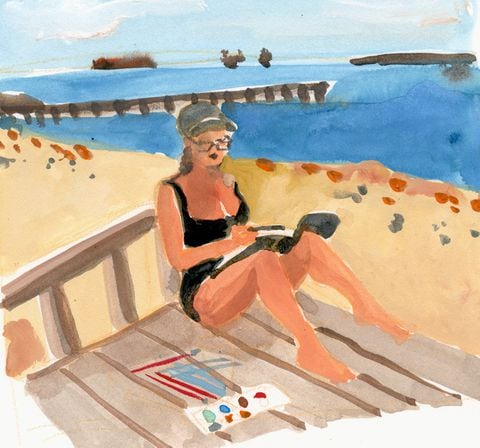 An illustration of Gayle Kabaker painting in her sketchbook.
An illustration of Gayle Kabaker painting in her sketchbook. Story and illustrations by Gayle Kabaker. Design by Eddie Alvarez.






